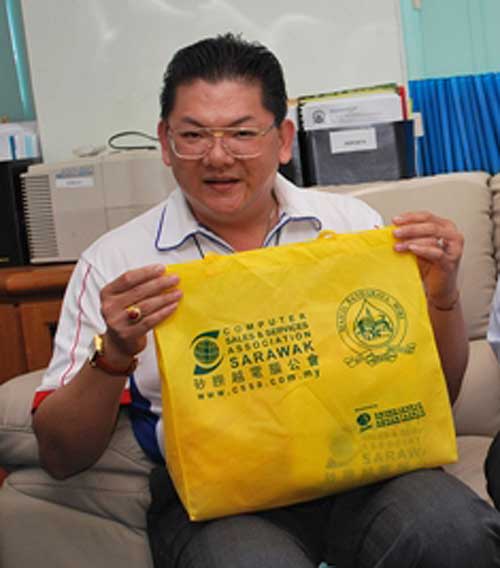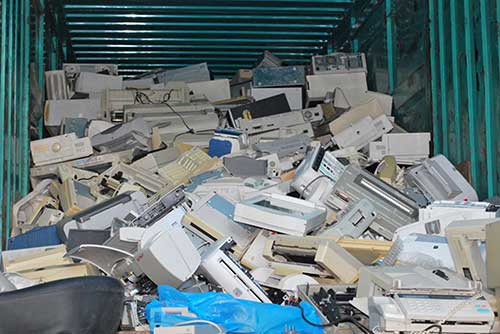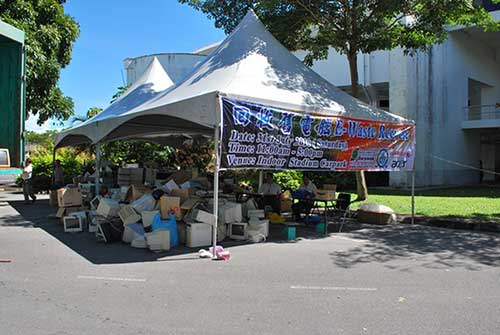THE solders on the printed circuit board (PCB) may be a very small part of a central processing unit (CPU).

FAIR EXCHANGE: Kuan showing an eco-bag which used to be given away in exchange for an old or obsolete computer at the annual Computer Expo.
But these small metal lumps — as well as the glass panel and gasket of the desktop — all contain lead which may cause damage to the human central and peripheral nervous system, kidney and blood system.
Not only that, the front panel of the monitor’s cathode ray tube (CRT) contains barium which may disrupt endocrine system functions while short-term exposure may cause muscle weakness and damage to the heart, liver and spleen.
These are just some examples of the toxic ingredients within a desktop and their effects on the human health system when exposed to them.
There are other toxic elements within other components of this electronic product.
For bigger electrical appliances such as refrigerators, the relays and switches contain mercury which, through constant contact, may accumulate in the kidney and liver, causing neural damage.
And like those of a desktop, other parts of a refrigerator also contain hazardous ingredients.
An unused desktop or a broken refrigerator, thus, has to be disposed of properly. Casual dumping in the ground or river will result in their toxic ingredients contaminating the ground (or groundwater) or the river they come into contact with.
Large quantity of toxic ingredients will pose health threats to the residents living in the locality or vicinity.
Almost every electronic and electrical appliance contains toxic ingredients. Hence, such unused products, termed as electrical and electronic waste (e-waste), is categorised as scheduled waste under the code SW 110, First Schedule, Environmental Quality (Scheduled Wastes) Regulations, 2007.
Under this Schedule, e-waste is defined as “waste from the assembly of electrical or electronic appliances comprising components such as accumulators, mercury-switches, glass from CRTs and other activated glass or polychorinated biphenyl-capacitors, or contaminated with cadmium, mercury, lead, nickle, chromium, copper, lithium, silver, manganese or polychlroinated biphehy.”
E-waste also represents waste components from appliances that can no longer be used such as electric cables, mobile phones, wastes or products processed out of the partial recovery facilities, televisions, air-conditioning units, computers, refrigerators, washing machines, video recorders, telephones, photocopy machines, facsimile machines, microwave/ovens, radios, printers and accessories, audio amplifiers and electronic game devices.
The list is inexhaustible.
e-waste volume still manageable
For Trienekens (Sarawak) Sdn Bhd, a licensed household rubbish collector, there have been e-waste dumping cases but not on an alarming scale yet.
However, as a company also licensed for partial reclycling and recovering of e-waste, Trienekens has taken note of an escalation in e-waste dumping in recent years, correlating the rising volume to the state’s economic activities.
According to Trienekens general manager (business development) Elvin Wee, the most common type of e-waste received by the company is used computers.

POLICY NEEDED: Sarawak which is on its way to becoming an industrial state needs a policy to regulate the disposal of e-waste which will become a major issue in years to come in view of the rapid pace of development in the state.
“Our e-waste customers are primarily large companies which adhere strictly to the scheduled waste management policies set by the regulatory bodies. The e-waste received is incinerated,” he explained.
As there is no clear policy or concrete procedure for the disposal of household e-waste, the public have been left to discard their e-waste in whichever way they deem fit.
Some do it through illegal dumping while the civic-minded would send their unused electronic and electrical products to permanent recyle centres provided by recycle contractors or temporary recycle venues set up by the local councils or non-governmental organisations (NGOs) or jointly by both.
As e-waste dumping has never hogged the headlines, whatever voluntary e-waste collecting system provided by the local councils, private sector and NGOs is presumed to be still adequate.
Systematic e-waste disposal
However, in view of Sarawak’s development, its increasing affluence and the fact that the lifespan of e-products is getting shorter, a regulated and systematic procedure for e-waste disposal should be introduced.

ORDERLY DISPOSAL: Used electrical and electronic products are collected at this makeshift collection centre to help preserve the environment.
“As Sarawak becomes more industrialised, it’s our duty as members of the local community to realise the importance of proper waste disposal to environmental preservation.
“Developing and implementing a waste management system specific to e-waste requires comprehensive data on present and anticipated e-waste situations as well as supportive policies.
“The ability to put in place such a system through environmentally sound technologies takes into account a number of technical, financial, institutional, economic and social factors,” Wee said.
Meanwhile, in the absence of regulated disposal of household e-waste, local authorities such as the Miri City Council (MCC) and NGOs such as the Computer Sales and Services Association Sarawak (CSSA) have been collaborating to ensure all e-waste in Miri end up in the right place.
Miri has three e-waste collecting centres operating on an ad hoc basis. Both MCC and CSSA are hoping for a permanent e-waste recycle centre in the face increasing demand.
Ideally, the council should have a designated space for the public to dump their e-waste, especially when Miri is moving towards becoming a green resort city.
“With a proper place to throw away unused electrical and electronic products, e-waste dumping will be reduced. When these products are properly recycled or recovered, our environment will become cleaner as well,” MCC chairman Lawrence Lai said.
Two main categories
There are two main categories of e-waste – one produced by industries and the other by households via used televisions, used computers, used refrigerators, used washing machines and the like.
Because of Sarawak’s present low population density, e-waste has yet to pose a problem to the environment.
According to the Department of Environment, there have, so far, been no massive e-waste dumping cases. But it does not mean awareness effort should only be made when e-waste dumping reaches an alarming stage.
According to State Department of Environment director Ruslan Mohamad, the Department of Environment (DOE) Malaysia does cater for industrial e-waste disposal but has yet to establish a concrete procedure for eliminating household e-waste.
In 2011, about 4,050 tonnes of scheduled waste (e-waste) were generated by industries in Sarawak and as of now, 37 licences have been approved by the state DOE for transportating various scheduled wastes.
“The licensed contractors collect the waste and transport it to DOE-approved partial or full recovery facilities,” Ruslan told thesundaypost.
While industrial e-waste is properly disposed of by licensed companies for recycling and recovering locally or shipped to peninsular Malaysia for further recycling and recovering, the same cannot be said of household e-waste due to a lack of policy to regulate its proper disposal.
Greener future
To meet the need for a greener future, MCC and CSSA have, since five years ago, been working together to educate the public on proper disposal of e-waste through the E-waste Recycle Campaign, held concurrently with the annual Computer Expo.
“When I became mayor five years ago, MCC and CSSA agreed the latter should also collect used computers and unused or obsolete laptops when they held the Expo. It’s a win-win situation,” Lai added.
To encourage public participation, both organisations had been giving away eco-bags to those who brought their unused e-products to the Expo.
Last year, the council decided to give parking coupons instead as a token of appreciation to the public for helping to conserve resources and the environment.
Another notable effort was that since last year, MCC and CSSA have been collecting not only used computers and related products but also electrical products such as refrigerators and air-conditioning units.
For CSSA chairman Victor Kuan, creating awareness of proper e-waste disposal is very important.
From the outset, the Association has been drawing up programmes and plans to educate the public on proper e-waste disposal which may otherwise adversely impact the environment.
“We are now applying for an e-waste recycle centre in Sibu and will soon also present our proposal to set up one in Miri.
“The mayor (Lai) is viewing our proposal positively. The problem is that we cannot identify a suitable location. So the proposal is still at a very early stage,” Kuan said.
As the scenario in Kuching is totally different with a number of companies licensed to handle e-waste reycling or disposal, Kuan said there was no need to set up more reycling centres in the Cat City.
However, he stressed education on proper e-waste recycling and disposal must start now.
But this should not depend on just one or two parties if it is to have any meaningful impact.
“Everyone must chip in ensure the effort is effective,” Kuan added.
